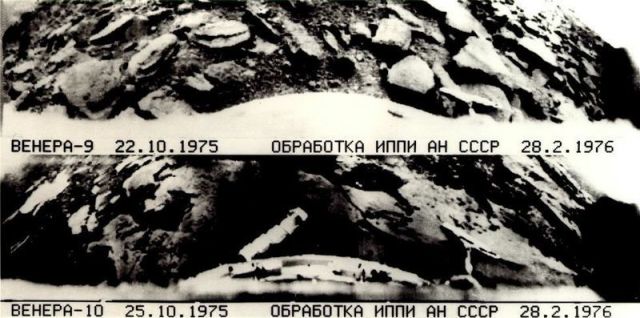Among the published archival documents is an extract from the minutes of the meeting of the Board of the Ministry of General Engineering, during which the prospects for the development of spacecraft for the study of the planets of the Solar system, including Venus in 1972, were consideredMOSCOW, September 8.
/tass/. Roscosmos published part of the declassified documents on the preparation and conduct of the flight of the automatic interplanetary station "Venus-8", which landed on Venus in 1972 and was able to study not only the atmosphere of the planet, but also its surface layer. This was announced on Thursday by the press service of the state corporation.
"Half a century ago, on July 22, 1972, the descent vehicle of the Soviet automatic interplanetary station "Venus-8", created in the Scientific and Production Association named after S. A. Lavochkin (part of the state corporation "Roscosmos"), landed on Venus, transmitting to scientists data on the parameters of the planet's atmosphere, the level of illumination on its surface and the nature of Venusian rocks," the message on the website says Roscosmos.
Among the published archival documents is an extract from the minutes of the meeting of the Board of the Ministry of General Engineering, during which the prospects for the development of spacecraft for exploring the planets of the Solar system, including Venus in 1972, were considered. The statement informs about plans to create promising devices.
The materials of the case prepared by the USSR Aviation Sports Federation and submitted to the International Aviation Federation for fixing the established world record for the duration of the active existence of the Venus-8 station on the surface of Venus have also been published.
The predecessor of the device - "Venus-7" - made the first soft landing on the surface of the planet on December 15, 1970 and sent radio signals from it. Its mass was 500 kg. Due to the difficult conditions on the surface of Venus - a pressure of about 100 atmospheres and a temperature of almost 500 degrees Celsius - when the device entered the atmosphere, a telemetry switch failed. As a result, Venus-7 was able to transmit only information about the ambient temperature. Directly on the surface of the planet, the station worked for 20 minutes, then the internal equipment heated up to 500 degrees and stopped working.
When creating a new device, the shortcomings of the previous station were taken into account. The published Venus-8 case states that the lander was structurally significantly modified. Based on the data obtained by Venus-7, the calculated values of the destructive load on the hull and the values of the maximum ambient temperature were reduced.
"This made it possible to facilitate the design of the power body of the Venus-8 lander. By reducing the weight of the structure, additional scientific instruments were installed and measures were taken to increase the time of the equipment on the surface of the planet," the case file clarifies.
"The list of measures to eliminate the comments identified during the flight of the object B-70 (station "Venus-7" - approx. TASS), sufficiently takes into account the conclusions and recommendations of the emergency commissions, and the measures have been implemented at the B-72 facility ("Venus-8" - approx. TASS)," says the conclusion of the expert commission on the Venus-8 apparatus, sent to the chairman of the Interdepartmental Scientific and Technical Council for Space Research at the USSR Academy of Sciences M. V. Keldysh.
According to the conclusion of the expert commission, the technical decisions taken during the development of the B-72 facility and its systems are correct, and the planned volume of ground tests for the facility is sufficient. "The B-72 object can be admitted to flight design tests," the document emphasizes.
The station was launched on March 27 from the Baikonur cosmodrome using a Molniya-M launch vehicle. According to the documents, the weight of the lander was 495 kg. The station reached Venus on July 22.
"At an altitude of about 55 km, a parachute opened and information began to be transmitted from the descent vehicle. After 55 minutes of smooth parachute descent in the atmosphere, the device, having a vertical speed of 8.3 m / s, landed on the illuminated side of Venus at 12:28:40 Moscow time at a point with coordinates 10 ° S and 335 ° VD," the Roscosmos website says.
According to the published documents, the scientific equipment installed on Venus-8 provided a solution to a number of tasks. These include measuring temperature and pressure on the day side of Venus; measuring illumination in the atmosphere and near the surface of the planet; determining wind speed at various levels in the atmosphere; determining the ammonia content in the atmosphere; measuring overloads at the aerodynamic braking site; determining the physical characteristics of the surface layer and the nature of surface rocks at the landing site of the lander.
After landing, the reception of information from the lander continued for another 50 minutes and 11 seconds, thus setting a new record for the duration of stay on the surface of Venus. "Data from scientific instruments showed that the temperature and pressure of the atmosphere at the surface at the landing site of Venus-8 were, respectively, 470 ± 8 ° C and 90 ± 1.5 atmospheres, and the illumination of the surface at a Sun angle of 5.5 ° was 350 ± 150 lux. When descending at altitudes of about 46 and 33 km, a volume content of 0.01-0.1% ammonia was recorded in the atmosphere, at altitudes of 50 and 0-11 km, the wind speed was 50-60 and 0-2 m/s, respectively," the report says.
According to the results of the research, it was concluded that the surface layer of Venus in the area of the landing site of the device is quite loose with a soil density of 1.4 g / cm3, and the soil itself resembled terrestrial granite rocks.

